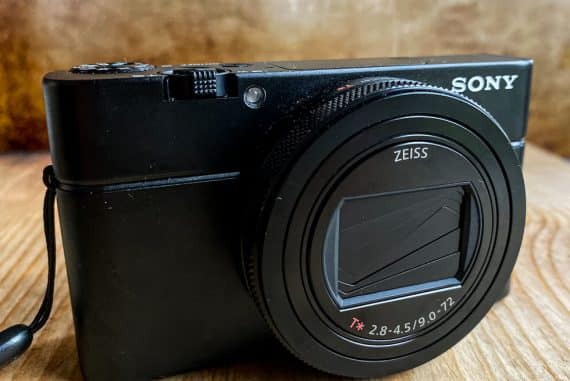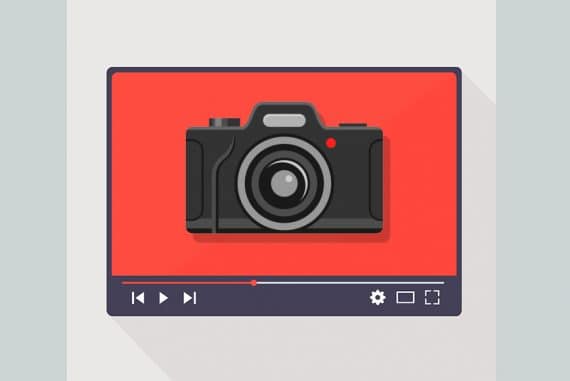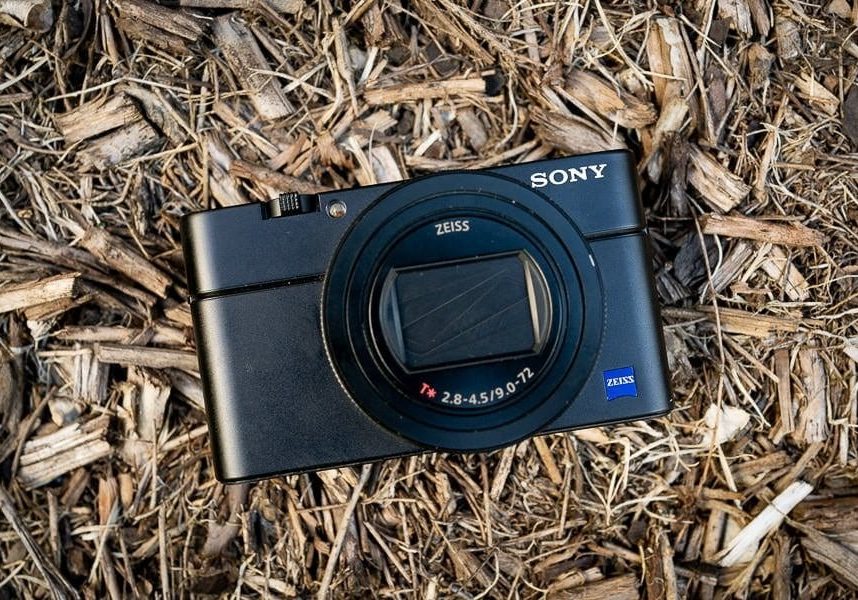
Sony RX100 VI Digital Compact Camera Review
In-depth, real-world Sony RX100 VI review by a professional photographer looking for a compact camera for everyday use and travel. Includes RX100VI vs V.
This is my review of the Sony RX100 VI, a compact camera released back in July 2018 to much fanfare in the photography industry, for its ground-breaking zoom lens, lightning-fast auto focus capabilities, and all round impressive shooting performance.
Thanks to Casey Neistat and a handful of other popular YouTubers who heaped their praises on its performance, I was keen to find out whether its price tag was justified.
After all, let’s not beat around the bush here – the Sony RX100 VI is one pricey compact camera – click the image below to see how much it’s retailing for in your country:

Impressive zoom range, AF speed & image quality. Perfect for travel.
In an age where smartphones can produce images and video that rival dedicated cameras (at least, to the untrained eye), is it really wise to invest over a thousand bucks on a Sony point-and-shoot camera?
Furthermore, with the wide selection of compact cameras available in 2024, does this little Sony really stand so far above the competition to justify its price tag?
I spent a few weeks finding out… and was actually quite surprised.
Sony RX100 VI Review | Intro
Let’s get some specs out the way first – how does the Sony RX100 VI look on paper?
Well, pretty damn good, actually:
Resolution: 20.1 Megapixels
Sensor size: 1 inch (13.2mm x 8.8mm)
Lens: 8x zoom (24-200mm eq.)
Viewfinder: Popup EVF/LCD
Native ISO: 125 – 12,800
Extended ISO: 80 – 25,600
Aperture: f/2.8-4.5
Dimensions: 4 x 2.3 x 1.7 in. (102 x 58 x 43 mm)
Weight: 10.6 oz (301 g) inc. battery
The RX100 series is something of a cult obsession for Sony enthusiasts, for anyone wanting the excellent imaging performance out of something the size of a pack of playing cards.
Launched way back in 2012, the first RX100 was named as the “European Advanced Compact Camera for 2012–2013” by the European Imaging and Sound Association, and one of the ‘Best Inventions of 2012’ by TIME.
To say that the sixth version in the series has had big shoes to fill is an understatement. I admire Sony’s desire to keep improving on what was once considered the best compact camera in the world, and with the Sony RX100 VI, they don’t disappoint.
The fifth version of the RX100 series was a great camera, as so was each before it. You could argue that the sixth edition doesn’t bring all that much new technology to the table to warrant its elevated price, but we’ll look at that later in the review.
In the meantime, you’re reading this to get a first hand impression on whether the Sony RX100 VI is worth the money, and who exactly it’s for.
Let’s have a look at what I like and dislike about this camera.
What I like about the Sony RX100 VI
Size/Weight Advantage
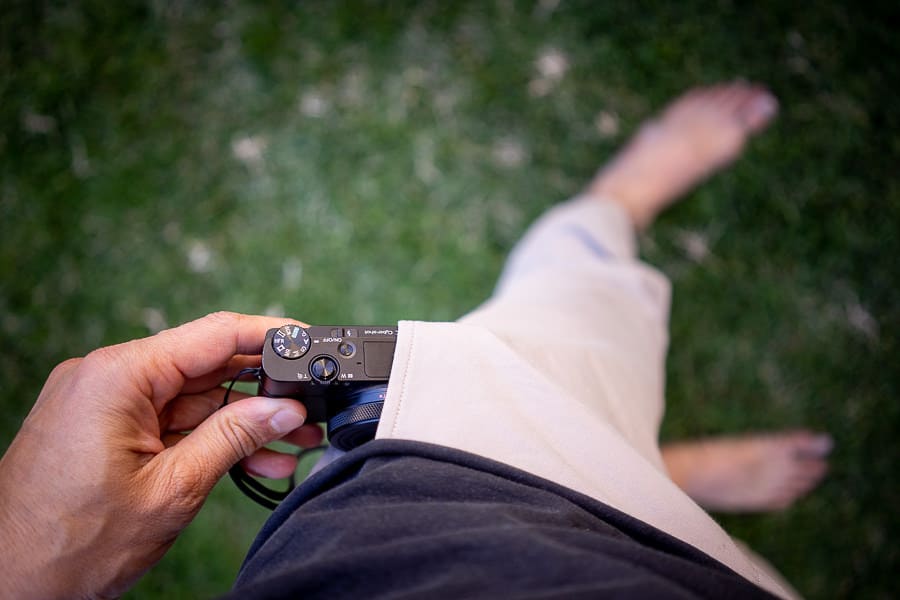
The Sony RX100 VI is so small that it can slide easily in and out of your trouser pocket.
Make no mistake – the Sony RX100 VI is a pocketable compact camera. The definition ‘compact’ or ‘point and shoot’ is rather vague, but I take it to mean ‘a fixed lens camera that can fit easily into a jacket pocket.’
The Sony RX100 VI can actually slide relatively unnoticed into the pocket of your jeans – it’s smaller than the average smart phone, albeit twice as thick.
With the quality of the average smartphone photo/video being so good these days, it’s important that your compact camera be small and light enough to ensure you actually take it with you, everywhere. I’m pleased to say that with the Sony RX100 VI, this is definitely the case.
To have such incredible performance, not to mention a 24-200mm lens right there in your front pocket, is mind-blowing. Let’s look closer at that lens…
Incredible Zoom Range
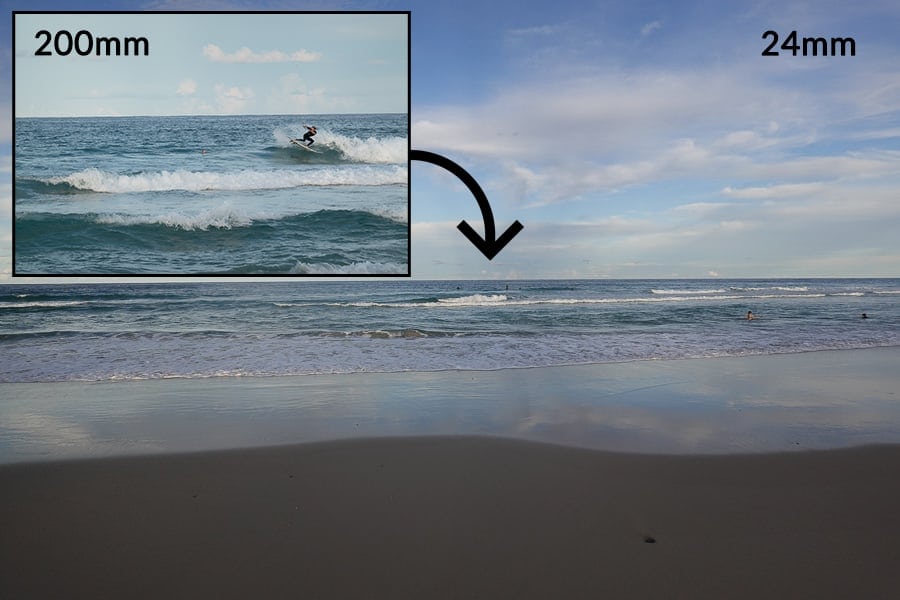
Stood on the beach I took my initial shot at 24mm, followed by the next at 200mm.
This right here is the numero uno reason for anyone to splash over a grand on this pocket rocket of a camera.
No matter what camera system you normally shoot, your zoom lens is probably a beast. The average 24-70mm looks like a couple of cans of dog food stacked up. A 70-200mm is the same but heavier.
The Sony RX100 VI sports a power zoom that’s equivalent to a 24-200mm f/2.8-4 lens. When you’re done shooting, it retracts completely into the camera’s svelte body. Think about that for a minute:
With the Sony RX100 VI, you can go from wide angle to telephoto in a second, then have it all packed away in your pocket for the next time you need to amaze someone with the size of your lens ;-)
I’m not normally interested in zoom lenses – the myriad focal lengths confuse my small brain, and I find it harder to compose…!
However, with the Sony RX100 VI, I found myself zooming in and out all the time, and taking full advantage of never needing to move my feet!
Shooting at 200mm (f/4) yields some great bokeh, and I love the fact that my subject is always unaware of my presence during the shot – the photo below of our son Harry was taken from a distance of about 15m (49ft), at 200mm.

Sony RX100 VI @200mm | 1/200 f/4.5 ISO400
Obviously, having such range is also immensely useful when you can’t physically move closer to your subject, like for photos of surfers from the beach or landscape elements when traveling.
At the wider end, performance was good too, with pleasing bokeh achievable when close to your subject and shooting wide open at f/2.8.
Mind-Blowing Auto-Focus Performance
If you’ve ever used a recent Sony mirrorless camera, you’ll know what the craic is when I talk about mind-blowing AF performance… it’s fast A.F. ;-)
By the time you read this, all the major brands will be offering their version of Eye AF… but none come close to Sony’s version.
Being able to point the Sony RX100 VI in the general direction of our energetic 4 year old, hold down the custom assigned Eye AF button, and have one of the 315 AF points lock onto his frickin’ EYE BALL, dammit!! What is this witch-craft before me?!
Coupled with the latest ‘Real Time Eye AF’ functionality which constantly searches for eyes and faces whenever there’s a subject in scene, capturing people (and now animals!) in motion is made easier than with any other brand of camera.
If you’ve never experienced Sony’s Eye AF, prepare to be dazzled… and if you’ve got children or pets and are sick of chasing them around the viewfinder frame with a single AF point (that was me, circa 2017!), this is the technology for you.
I’ve been spoiled with the insane AF performance of my Sony a7III, so was pleasantly surprised to see the Sony RX100 VI could hold its own in that department too – not quite as good as its big MILC brother, but still pretty damn impressive.
Lightning-Fast Burst Mode
24 frames-per-second. WTF?!
Seriously, who needs 24fps on a stills camera?! That’s video, for god’s sake! After engaging Continuous Shooting mode on the RX100 VI, the first thing I did was to change the Drive Mode from High to Medium… and even that seemed too fast!
If you’re someone who derives pleasure from hearing a (fake) shutter noise rattling off 24 times a second like Terminator’s gattling gun, you’re going to love letting rip with the Sony RX100 VI.
I understand that in certain situations, someone might need 24 frames per second. I’m not quite sure who nor when, but it’s nice to know it’s there… for… say… photographing humming birds?!
You can shoot around 110 RAW photos (or about 220 Fine JPEGs) before things start to slow down, and the camera needs around a minute to clear the buffer in both cases. (Serves you right for shooting like a mad man!)
It’s worth investing in some top spec UHS-I memory cards to maximise the performance, but don’t waste your money on the UHS-II cards since the Sony RX100 VI doesn’t support the interface.
While the buffer is clearing, you can’t shoot any more bursts, but you can still make setting changes and review your images – thankfully the camera doesn’t lock up completely, and is testament to the incredible processor squashed up somewhere in the camera.
The ‘HFR’ High Frame Rate mode deserves a mention here too – video isn’t my forte, but being able to film snippets, then play them back at 1000fps is frankly astounding, and will make you want to film everything in super slow-mo.
One thing to remember is that the scene needs to be very well lit for HFR, so the camera doesn’t need to resort to higher ISOs and a noisier final video.
The settings and operation of HFR mode were a little confusing, and it’s even worse trying to explain them, so I’ll leave it to this article, and Casey’s video above – check out the helicopter blades at 2m56!
Unless you’re a vlogger, I can see HFR mode reserved mostly for impressing your mates. I had a short play with it, said a few “whooooahs”, then promptly forgot about its existence on the camera altogether.
Great Image Quality

Straight out of camera JPEG and the skin tones are decent considering we were in shade | 1/320 f/2.8 ISO100
The Sony RX100 VI features a 1 inch, 20.1MP Exmor RS Stacked BSI-CMOS sensor – quite a mouthful, which basically means that for its size, it’s pretty much the mutt’s nuts 🐶👍🏼.
It’s also the same sensor as found in the previous 2 iterations of this camera… make of that what you will.
JPEG performance is fine for those wanting to shoot and share straight out of camera (with WiFi and NFC, transferring images is fast and easy), but at this price let’s face it – you’ll be wanting to shoot RAWs.
ISO performance was fine for a sensor of this size, with images perfectly usable up to around ISO 1600, then degrading slowly to 3200, and very fast after that. In low light, I didn’t mind letting ISOs creep high up, safe in the knowledge that I’d be doing a ‘dirty B&W edit’ – the oldest trick in the book :p
Previous versions of the RX100 featured a faster lens (e.g. f/1.8-2.8 in the RX100V), but the Sony RX100 VI sacrifices some light in favour of the extended reach of its lens.
Thankfully, to compensate, the Sony RX100 VI also offers 4-stop image stabilization, which helps when shooting at 200mm in particular.

Underexposing the Sony RX100 VI at low ISOs allows for some leeway in post | f/2.8 1/100 ISO100

Image pushed 3.5 stops in Lightroom – not bad!
Dynamic range was decent for a 1 inch sensor – you can recover about 3~4 stops of shadow when processing an underexposed image, as long as it was shot at low ISOs.
This is a good crutch to have when you mess up your exposure, or decide to underexpose deliberately to preserve highlights, as many wedding photographers, and those unable to control certaining lighting situations are forced to do.
Front Facing LCD Screen

The front facing screen of the RX100 VI features a handy countdown timer for selfies and recording yourself.
Lots of compact cameras have this feature nowadays, and I’m glad the RX100 VI didn’t skip the trend.
I never used to value having an LCD screen that flips to face the front until, a) I started needing to film myself for videos, and b) I had kids to take selfies with (see image in previous section).
The flipping action of the screen on the Sony RX100 VI is pretty much perfect – you can even do it one-handed.
(I find it odd why the same feature on the Sony a6400 was implemented so clunkily, when the a6400 is the newer camera – see our Sony a6400 review to see what I mean.)
A nice additional touch is that when you flip the screen forward, the camera enters ‘selfie mode’, with a visible countdown timer allowing you to compose the shot properly.
Customisable Lens Ring
When Canon did this on the lenses of their Canon R, I thought it was a great idea… then I realised that it’s been a feature on select compact camera models for a while, including the Sony RX100 VI.
You can assign the control ring of the lens to control Aperture, Shutter Speed, ISO, or my personal recommendation, Exposure Compensation.
This means that while shooting in Aperture Priority, I can set the camera to AUTO ISO, use the control wheel on the back of the body to select the Aperture, and use the lens ring to over/under expose when necessary – all in all, a very intuitive, simple and enjoyable way to shoot.
What I dislike about the Sony RX100 VI
Questionable Ergonomics
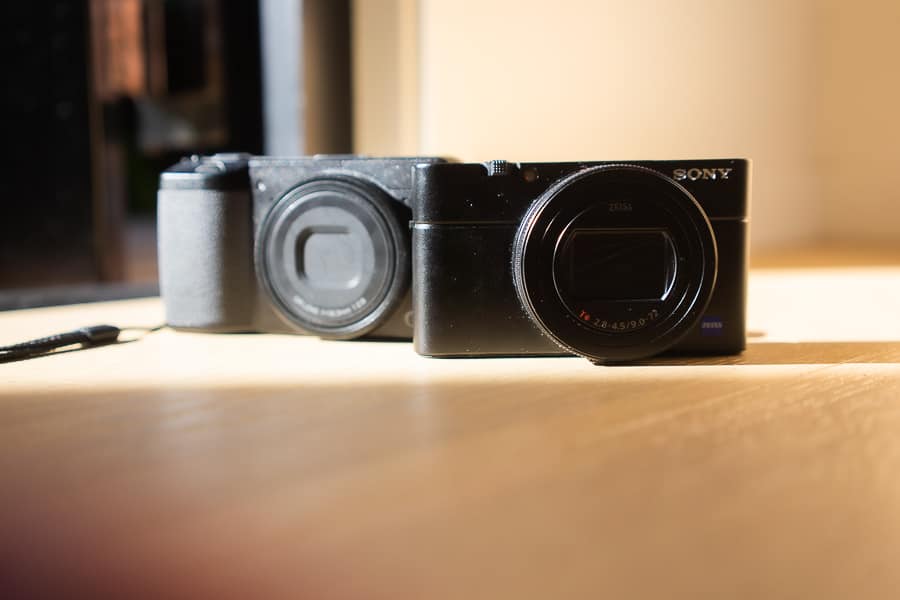
I wish the RX100 VI had a pronounced, rubber grip, such as the one on the Ricoh GRIII.
Sony is well and truly in the Apple camp when it comes to product design, i.e. form over function. Handling an iPhone without a case is akin to handling the Sony RX100 VI – it’s one slippery sucker!
Imagine holding a pane of glass. Now imagine that it’s a pane of glass that costs over $1,000… and a pane of glass that you’ll be removing from your pocket multiple times a day, usually in a swift pulling motion. It’s a slippery recipe for disaster…
The first accessory anyone should buy after they get the Sony RX100 VI is this rubber grip. Thankfully it’s cheap – think of it as the rubber case to your iPhone. Trust me, it’s essential.
After you’ve transformed the grip of your new toy from that of a wet bar of soap to a slightly dryer one, it’s time to talk a bit more about the questionable ergonomics of this camera.
This might seem like nit-picking, but to me it’s a glaring omission – there’s no externally protruding wrist strap eyelet. I assume this was in keeping with the camera’s ‘form over function’ exterior design, but it means that you’re limited to the flimsy hand strap that comes with the camera as a ‘butter-fingers-backup’.
(To be fair, lots of other compact cameras only have the ‘flimsy wrist strap’ eyelet option – including the aforementioned Ricoh GRIII, for example – but I still find it a little odd that a camera at this price point, and one with zero grippable points of contact, doesn’t have a ‘proper’ eyelet.)
There are plenty of cheap cases for the RX100 series on Amazon, and you can always attach a more heavy-duty strap to the tripod socket on the base, but still – come on Sony. Don’t make such an expensive camera that’s so easy to drop!
Limited Touchscreen Functionality
For anyone familiar with the touchscreen on any of the recent Sony mirrorless cameras, the half-baked touchscreen performance of the RX100 VI won’t come as a surprise.
Top marks for Sony for including a nice 3″ tilting LCD screen (imo, all cameras need a tilting LCD screen), and for including touch-to-focus functionality… but why stop there?
Why limit the touchscreen to the most basic shooting functionality/playback navigation, but leave out no-brainer functions such as swiping to the next photo, or selecting menu items?!
It’s like the touchscreen engineer at Sony dropped dead half way through the build, and they couldn’t find a replacement. RIP usability.
Confusing Menus

All the Sony mirrorless cameras are hampered by confusing menus, but at least they’re all similar – if you’re already a Sony user, you’ll find the menu in the RX100 VI familiar.
This is another standard Sony rant, but the menus need some serious work on the Sony RX100 VI. The only caveat to this is if you’re coming from another Sony camera, in which case, it’s business as usual… albeit the most inefficient form of business imaginable.
Added to the illogical placement of menu items and head-scratch-inducing navigation, is Sony’s proprietary feature naming convention, which will have you hitting Google at every new menu tab…
I imagine it’d be a headache for Sony to translate in-camera explanations into multiple languages, but their cameras could really benefit from a built-in glossary of terms – if you’re stuck without phone reception, it’s hard to work out what certain functions mean, particularly with the confusing AF modes.
Poor Battery Life/Lack of Charger
Welcome to the world of high-spec compact cameras – be prepared to carry a spare battery (or ten…)
At around 240~300 shots per charge, to say the Sony RX100 VI is power-hungry would be an understatement.
However, with a tiny, feather-light battery and more ridiculous in-camera features than you can shake a stick at, it probably shouldn’t come as a surprise. Also, its performance is pretty much on par with other compact cameras.
Fortunately, spare batteries are affordable, and the Sony RX100 VI has the additional benefit of accepting power via a micro-USB port, meaning you can use your phone’s portable battery pack to keep it topped up.
Speaking of which, I find it rather stingy of Sony not to include a dedicated battery charger with such a high-priced camera. Yes, charging via the included micro-USB cable means less gadgetry to pack while traveling, but plugging the damn thing in is a frustrating experience, akin to threading a needle, with cold hands… in the dark.. when you’re drunk.
Seriously though, add a couple of spare batteries (make sure it’s the official Sony ones like these), and a dedicated charger (this can be third party, like this one), to the list of essential accessories for the Sony RX100 VI, and you’re all set.
It’s just a shame some of these things weren’t there to start with…
Sony RX100 VI vs RX100 V
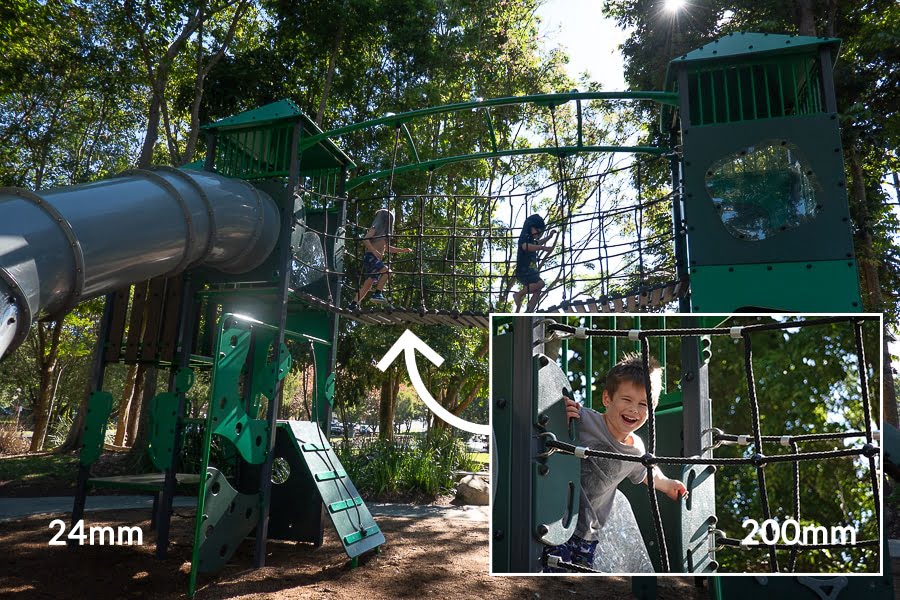
The RX100 VI features a 24-200mm f/2.8/4.5 zoom, whereas the older RX100 V features a 24-70mm f/1.8-2.8.
I thought this deserved its own section in my review of the Sony RX100 VI, since the previous iteration is rather attractively priced right now.
So, for roughly $350 more, what exactly is better in the VI when compared to the V?
Well, I’ll start with what’s worse, as that’s easier. Whereas the RX100V featured a gloriously fast f/1.8-2.8 equivalent lens, the RX100VI offers f/2.8-4.5, which is a shame, but understandable due to the difference in zoom range between the two cameras (24-70mm vs 24-200mm)
Aside from more zoom length, the rear screen rotates further downwards to 90° on the VI compared to 45° on the V, and is a touchscreen.
Auto focus is also faster on the VI, with Eye AF allegedly being twice as fast – that’s a big advantage.
Then there’s a faster image processor in the VI, which reduces time-lag in the viewfinder and improves on the general snappiness of the camera as a whole – another nice upgrade to the V. Buffer capacity is also better on the VI, for those with a heavy shutter finger.
There are a couple more minor differences between the two cameras, but that’s the long and short of it. If you’re coming straight to the RX100 series, you’ll probably be satisfied with the V… but you’ll be left wondering how much better VI is… and that’ll eat at you!
With technology, I usually recommend investing in the most recent version of anything, especially if you’re already spending a decent chunk of change. Technology moves fast, after all.
The benefits of the VI over the V may seem minor on paper, but they all add up. For me, the speed improvements all round are reason enough to go for the Sony RX100 VI.
Here’s a table I borrowed from Wikipedia showing the general differences in Sony RX100 models:
| Model | RX100 | RX100 II | RX100 III | RX100 IV | RX100 V | RX100 VI |
|---|---|---|---|---|---|---|
| Sensor | 20.1Mpx Exmor CMOS 13.2mm x 8.8mm |
20.1Mpx Exmor R BSI-CMOS 13.2mm x 8.8mm |
20.1Mpx Exmor RS Stacked BSI-CMOS 13.2mm x 8.8mm |
|||
| Processor | Bionz | Bionz X | ||||
| Lens Focal Length | 10.4 – 37.1mm (Equiv. 28-100mm) |
8.8 – 25.7mm (Equiv. 24-70mm) |
9.0 – 72mm (Equiv. 24-200mm) |
|||
| Lens max Aperture | f/1.8-4.9 | f/1.8-2.8 | f/2.8-4.5 | |||
| Shutter Speed | 30 ~ 1/2000 sec | 30 ~ 1/32000 sec | ||||
| Max Continuous Shooting | 10 frames/s | 16 frames/s | 24 frames/s | |||
| Video record format | MPEG-4, AVCHD (28 Mbit/s) Full HD |
MPEG-4, AVCHD (28 Mbit/s), XAVC S (50 Mbit/s) Full HD |
MPEG-4, AVCHD (28 Mbit/s), XAVC S (100 Mbit/s) 4K video |
|||
| Video Sampling | Line skipping | Full-pixel readout | ||||
| Slow Motion Video Record | No | Yes (240, 480, 960fps) |
Yes (250, 500, 1000fps) |
|||
| Professional Video edit | No | Picture Profile w/CineGamma, Timecode, Userbit |
||||
| Custom minimum shutter spd. at Auto ISO |
No | Yes | ||||
| AF Points | 25 | 315 | ||||
| AF Type | Contrast Detect | Phase Detect | ||||
| Flexible Spot with Lock on AF | No | Yes | ||||
| Continuous Eye-AF | No | Yes | ||||
| LCD | 3 inch fixed | 3 inch tilting (+90/-40 deg.) | 3 inch tilting (+180/-45 deg.) | 3 inch tilting touch screen (+180/-90 deg.) | ||
| EVF | No | Optional | Built-in | |||
| Hot shoe | No | Multi-Interface | No | |||
| Built-in ND filter | No | 3-stops | No | |||
| WiFi & NFC | No | Yes | ||||
| Battery-life (CIPA standards) |
330 shots | 350 shots | 320 shots | 280 shots | 220 shots | 240 shots |
| Weight | 240g | 281g | 290g | 298g | 299g | 301g |
| Dimension | 102 x 58 x 36 mm | 102 x 58 x 38 mm | 102 x 58 x 41 mm | 102 x 58 x 43 mm | ||
| Announced | Jun 6, 2012 | Jun 27, 2013 | May 28, 2014 | Jun 10, 2015 | Oct 6, 2016 | Jun 5, 2018 |
Source: Wikipedia
Final Words | Who is the Sony RX100VI for?

My wife took a liking to the tiny dimensions of the RX100 VI – seen here using the popup EVF. My father-in-law also was keen on one for his next cycling holiday…
At first I thought the Sony RX100 VI was a camera reserved for professionals who wanted an everyday compact with AF performance to match their workhorse camera.
However, the more people I showed it to, the more I realised its multi-faceted appeal.
The combination of blazing fast, reliable auto-focus that just works, and a zoom range that most people have never experienced before… let alone in a camera the size of a pack of cards, is incredibly alluring – for parents, travelers, the older generation, photography novices… basically anyone who wants the camera to do the majority of the work for them.
The Sony RX100 VI, as is the case with several of the latest Sony cameras, makes capturing moments easier than any other camera. Setting it up may be a pain in the butt, but once you have it ready, it’s pretty much an idiot-proof device – just don’t touch that labyrinth of a menu!
Once you’ve stuck on a rubber grip and have the flimsy strap around your wrist as a backup, you have a powerful and efficient means of taking photos of pretty much everything, from up close portraits to distant happenings… and it all stores away neatly in your back pocket.
The best camera is the one you have on you – we’ve all heard it, and the Sony RX100 VI means that said camera won’t always just be your smartphone. Yes, the latest smartphones are great for photography, but they can’t hold a light to something of this calibre.
The Sony RX100 VI is certainly an investment that only the privilege few will be able to make, but to those who do, you won’t regret your decision… unless you drop it, of course :-)

Impressive zoom range, AF speed & image quality. Perfect for travel.









